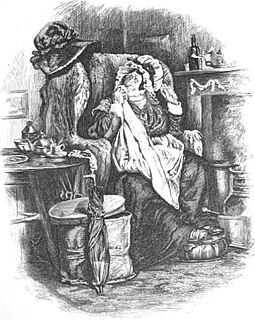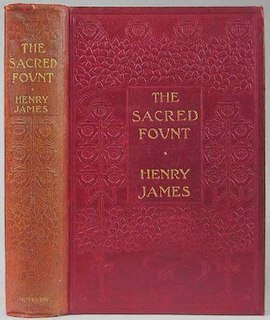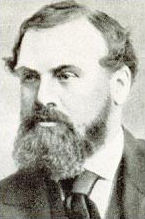
Charles John Huffam Dickens was an English writer and social critic. He created some of the world's best-known fictional characters and is regarded by many as the greatest novelist of the Victorian era. His works enjoyed unprecedented popularity during his lifetime, and by the 20th century, critics and scholars had recognised him as a literary genius. His novels and short stories are still widely read today.

David Copperfield is the eighth novel by Charles Dickens. The novel's full title is The Personal History, Adventures, Experience and Observation of David Copperfield the Younger of Blunderstone Rookery. It was first published as a serial in 1849–50, and as a book in 1850.

A cliffhanger, or cliffhanger ending, is a plot device in fiction which features a main character in a precarious or difficult dilemma, or confronted with a shocking revelation at the end of an episode of serialized fiction. A cliffhanger is hoped to incentivize the audience to return to see how the characters resolve the dilemma.

Barnard Castle is a market town in Teesdale, County Durham, England. It is named after the castle around which it was built. It is the main settlement in the Teesdale area, and is a popular tourist destination. The Bowes Museum has the best collection of European fine and decorative arts in the North of England, housed in a magnificent 19th-century French-style chateau. Its most famous exhibit is the 18th-century Silver Swan automaton, though art includes work by Goya and El Greco.
This article presents lists of the literary events and publications in 1840.

Barnaby Rudge: A Tale of the Riots of Eighty is a historical novel by British novelist Charles Dickens. Barnaby Rudge was one of two novels that Dickens published in his short-lived (1840–1841) weekly serial Master Humphrey's Clock. Barnaby Rudge is largely set during the Gordon Riots of 1780.

The Old Curiosity Shop is one of two novels which Charles Dickens published along with short stories in his weekly serial Master Humphrey's Clock, from 1840 to 1841. It was so popular that New York readers stormed the wharf when the ship bearing the final instalment arrived in 1841. The Old Curiosity Shop was printed in book form in 1841.

Master Humphrey's Clock was a weekly periodical edited and written entirely by Charles Dickens and published from 4 April 1840 to 4 December 1841. It began with a frame story in which Master Humphrey tells about himself and his small circle of friends, and their penchant for telling stories. Several short stories were included, followed by the novels The Old Curiosity Shop and Barnaby Rudge. It is generally thought that Dickens originally intended The Old Curiosity Shop as a short story like the others that had appeared in Master Humphrey's Clock, but after a few chapters decided to extend it into a novel. Master Humphrey appears as the first-person narrator in the first three chapters of The Old Curiosity Shop but then disappears, stating, "And now that I have carried this history so far in my own character and introduced these personages to the reader, I shall for the convenience of the narrative detach myself from its further course, and leave those who have prominent and necessary parts in it to speak and act for themselves."

Sarah or Sairey Gamp is a nurse in the novel Martin Chuzzlewit by Charles Dickens, first published as a serial in 1843–1844.
Sampson Brass is a fictional character in the 1841 novel The Old Curiosity Shop by Charles Dickens. He is a corrupt attorney who affects feeling for his clients, whom he then cheats.

The Sacred Fount is a novel by Henry James, first published in 1901. This strange, often baffling book concerns an unnamed narrator who attempts to discover the truth about the love lives of his fellow guests at a weekend party in the English countryside. He spurns the "detective and keyhole" methods as ignoble, and instead tries to decipher these relationships purely from the behavior and appearance of each guest. He expends huge resources of energy and ingenuity on his theories, much to the bemusement of some people at the party.

Daniel Quilp is one of the main antagonists in the novel The Old Curiosity Shop by Charles Dickens, written in 1840. Quilp is a vicious, ill-tempered and grotesque dwarf and is the villain of the story. Quilp is as near as Dickens ever came to creating a monster. Actors who have portrayed him include Hay Petrie, Anthony Newley, Patrick Troughton and Toby Jones.
Thomas Bentley (1884–1966) was a British film director. He directed 68 films between 1912 and 1941. He directed three films in the early DeForest Phonofilm sound-on-film process, The Man in the Street (1926), The Antidote (1927), and Acci-Dental Treatment (1928).
The Old Curiosity Shop is a Charles Dickens novel. It may also refer to several adaptations of the novel, including:

The Old Curiosity Shop is a 1934 British drama film directed by Thomas Bentley and starring Elaine Benson, Ben Webster and Hay Petrie. It is an adaptation of Charles Dickens' 1841 novel The Old Curiosity Shop.
The Bleak Old Shop of Stuff is a four-part comedy series produced by BBC, which premiered on BBC Two on 19 December 2011. It is a parody of the works of Charles Dickens, drawing its title from Bleak House and The Old Curiosity Shop. It is a television successor to Bleak Expectations, a radio parody of Dickens which began in 2007, and with which it shares the writer Mark Evans, producer Gareth Edwards and actor Richard Johnson; while not a direct adaptation it shares the same style, atmosphere and sense of humour. It is directed by Ben Gosling Fuller, who also directed the show That Mitchell and Webb Look.
The Old Curiosity Shop is a 1914 British silent drama film directed by Thomas Bentley and starring Mai Deacon, Warwick Buckland and Alma Taylor. It was based on the 1841 novel The Old Curiosity Shop by Charles Dickens, and was the first of three film adaptations of the story by Bentley. It was made by the Hepworth Company, the leading British film studio before the First World War.

The Old Curiosity Shop is a 1911 American silent short drama film produced by the Thanhouser Company. The film is an adaptation of the 1841 novel The Old Curiosity Shop by Charles Dickens that was limited to the time constrictions of the single reel format. The film focuses on the grandfather who gambles into poverty and the consequences which eventually claim the life of Little Nell. Its survival and attribution as a Thanhouser film was noted by Kamilla Elliott in her 2003 book Rethinking the Novel/Film Debate under the title Little Nell. In 2012, the work was confirmed to be a Thanhouser production at the Pordenone Silent Film Festival. The identification of the film as Little Nell arose due to head of the film having been lost.

Frederic Chapman was a publisher of the Victorian era who became a partner in Chapman & Hall, who published the works of Charles Dickens and Robert Browning and Elizabeth Barrett Browning, among others.

Mary Scott Hogarth was the sister of Catherine Dickens and the sister-in-law of Charles Dickens. Hogarth first met Charles Dickens at age 14, and after Dickens married Hogarth's sister Catherine, Mary lived with the couple for a year. Hogarth died suddenly in 1837, which caused Dickens to miss the publication dates for two novels: The Pickwick Papers and Oliver Twist. Hogarth later became the inspiration for a number of characters in Dickens novels, including Rose Maylie in Oliver Twist and Little Nell in The Old Curiosity Shop. Charles and Catherine Dickens' first child was named Mary in her memory.











